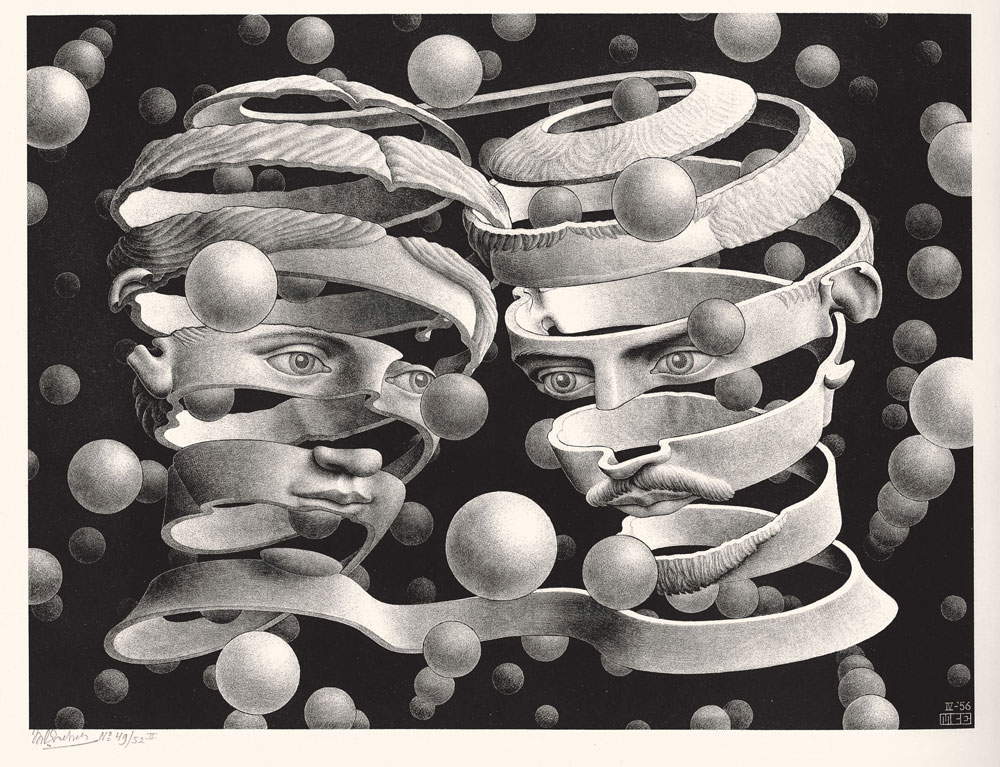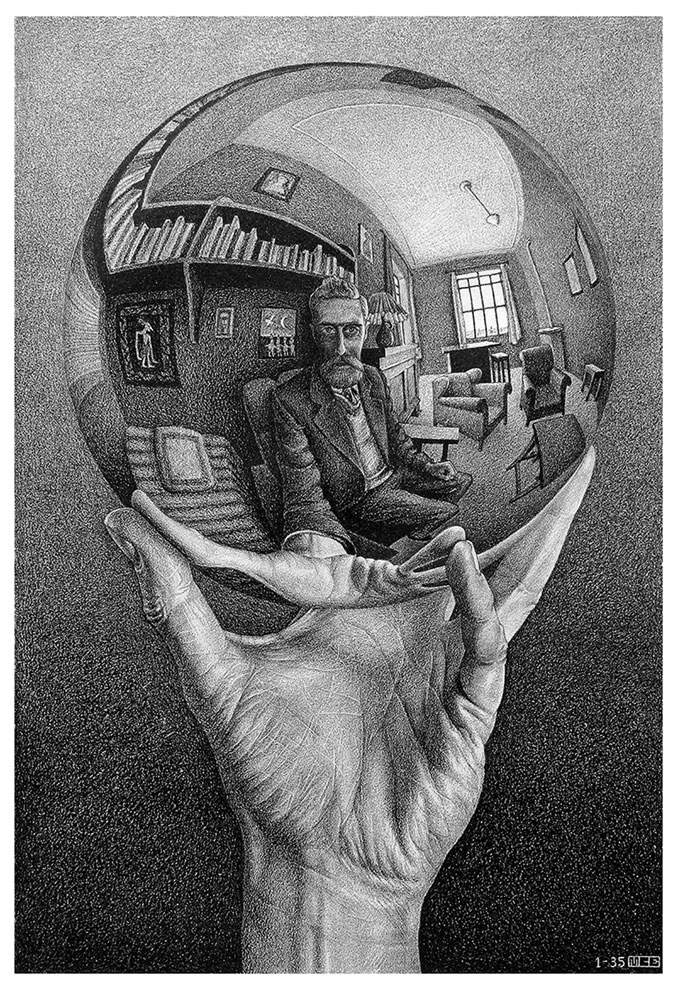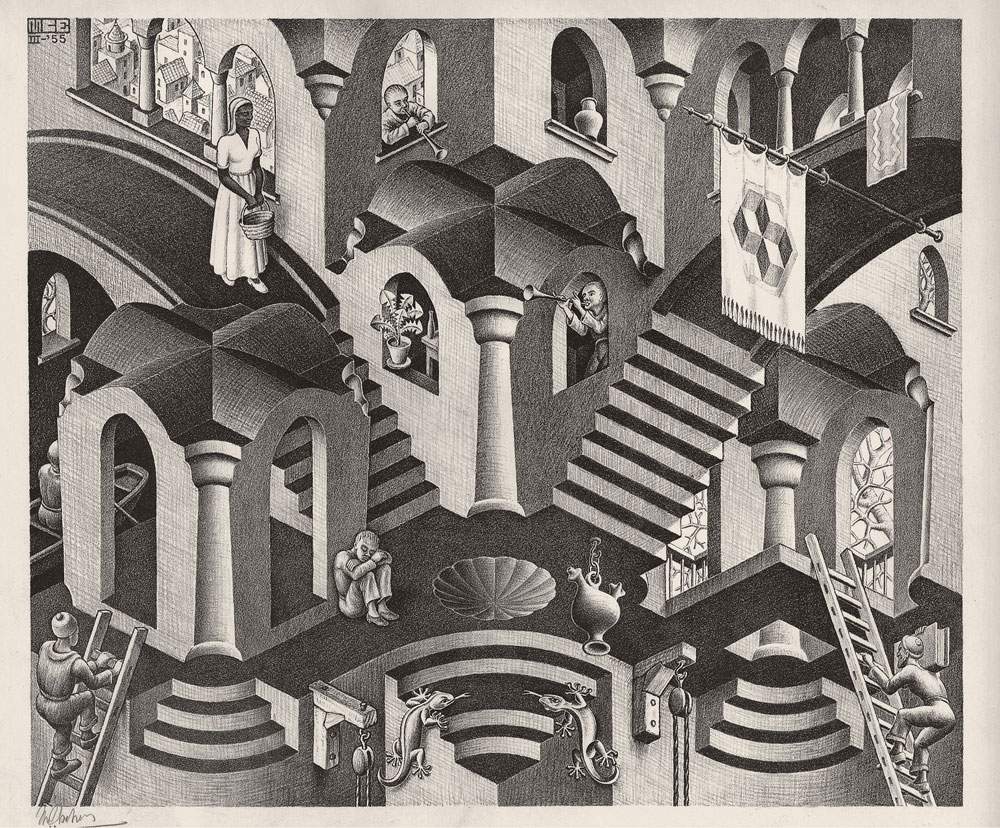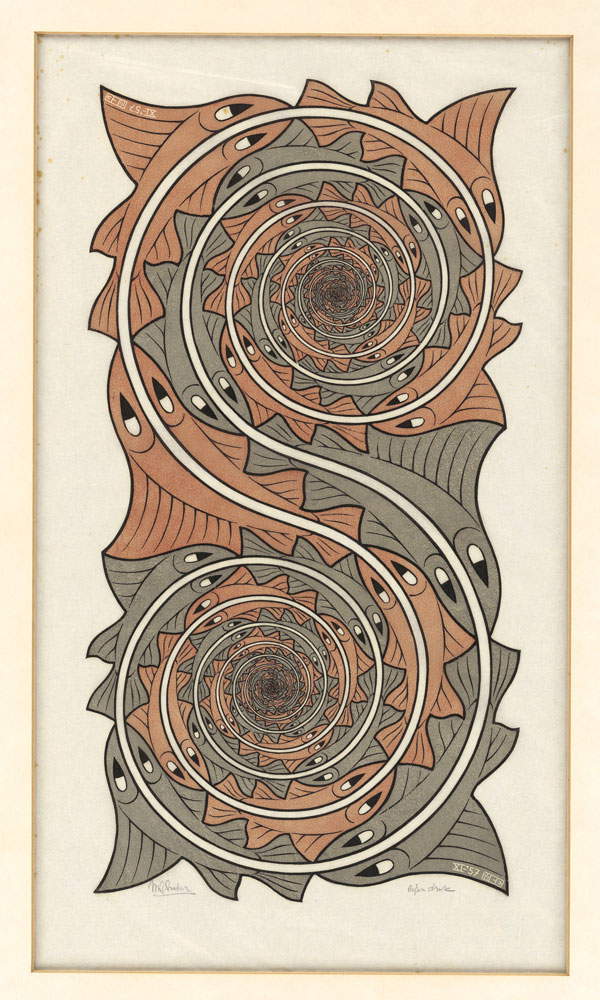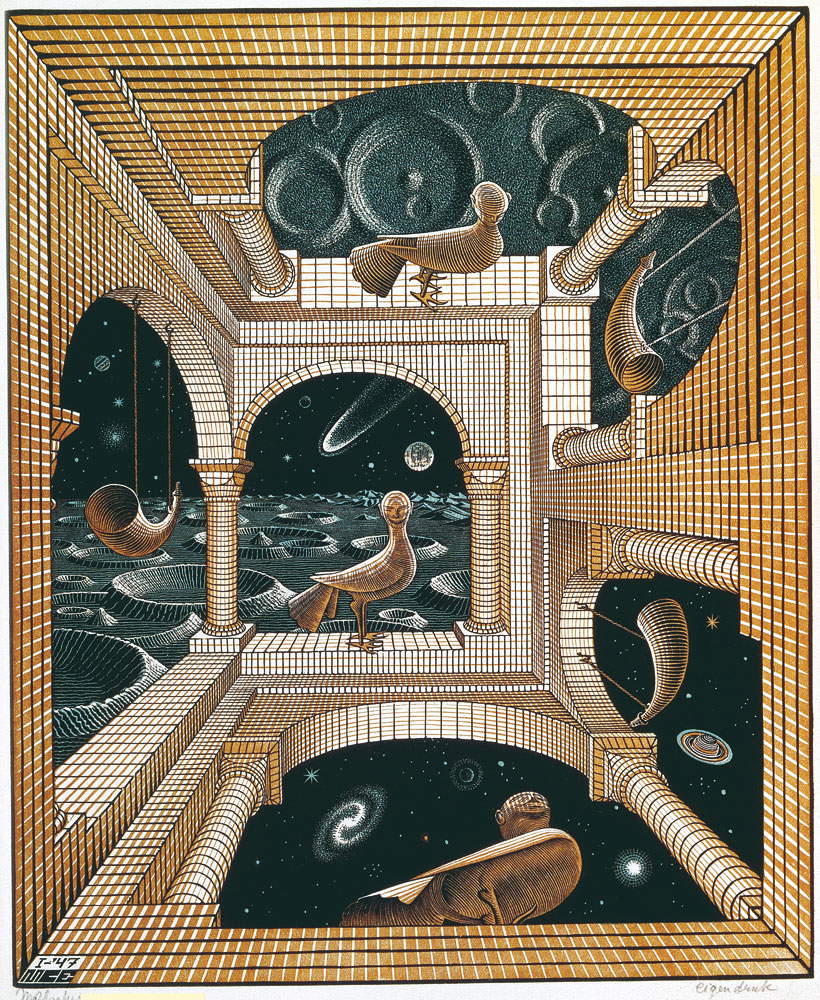by Luca Zuccala , published on 06/01/2017
Categories: Exhibition reviews
/ Disclaimer
Review of the exhibition 'Escher' in Milan, Palazzo Reale, from June 24 to January 22, 2017.
Dandelions, beetles, quartz. A dewdrop. Minutiae of nature composed of precious geometric structures, crystalline garments. Constructions contemplated as astonishing architectures, filtered into the algebraic lattices of the mind to be engraved. Light and graceful, like butterflies softening forms hovering from the hive that abstracts them, multiplying and interlocking in infinite sequences. Tessellations: structuring and filling the plane. Puzzles. Dowels growing and decreasing according to algorithm. The “regular division of the plane.” The first, in this case. The one in Milan’s Palazzo Reale, which houses the perceptual and perspective paradoxes of Maurits Cornelis Escher (1898-1972). Compenetration of simultaneous worlds through fluid metamorphic transformations. Two hundred pieces-assemblages structured regularly (and thematically) in six sections for a time dilated to the maximum. Seven months, from June 24, 2016 to January 22, 2017.
 |
| Maurits Cornelis Escher, Bond of Union (1956; lithograph, 25.3x33.9 cm; Giudiceandrea Federico Collection; All M.C. Escher works © 2016 The M.C. Escher Company) |
 |
| Maurits Cornelis Escher, Hand with Reflecting Sphere (1935; lithograph, 31.1 x 21.3 cm; M.C. Escher Foundation; All M.C. Escher works © 2016 The M.C. Escher Company) |
 |
| Maurits Cornelis Escher, Scarabs (1935; woodcut, 18 x 24 cm; Giudiceandrea Federico Collection; All M.C. Escher works © 2016 The M.C. Escher Company) |
An exhibition that continues and pursues the success of the past stages. In chronological sequence: Roman (200 works for 240 thousand visitors), Bolognese (150 works for 175 thousand visitors) and Treviso (140 works for 170 thousand visitors, eighth most visited exhibition in Italy in 2016). Proven format, assured success. With the addition of three ingredients: a few more works and comparisons with the “past”; renewed multimedia contribution; more “sophisticated” playful interaction than in previous editions. The game is done. Literally: double combination of “The Games of the Exhibition” + “Living Escher” to reflect infinitely in the mirror room, optical wall that gives a sense of illusory depth. Optical entertainment to test the famous “tricks of vision.” And off with selfies and surreal videos concentrating one inside the other like sophisticated matryoshkas. Or sophisticated puppets.
Uses and abuses of the Dutch engraver’s optical and artistic lesson also reverberate well in the last section. Escher’s “lesson,” after the many and scarce later and coeval emulators and imitators. Twentieth-century and contemporary culture grappling with the artist’s legacy. Graphic paradoxes translated onto videos, covers, T-shirts and multifarious gadgets. The last stage of a chronological exhibition itinerary that punctuates and plumbs the biographical, artistic and geographical stages of the Dutch master: from the Netherlands to Italy, from Rome to Apulia to sulphurous Sicily, sifting through the entire Apennine ridge on foot or by mule. Magna Graecia and the Middle Ages, Mannerism and Modernism: from the Doric rigor of Segesta to Central European Art Nouveau efflorescence; from the stones of Atrani to the chromolithographs of Kolo Moser. A creative parabola that from the early twentieth-century experiments of the Viennese Ver Sacrum is infected with surrealist dreamlike fantasy, illuminating itself with the auroras of post-World War I Italic aeropainting. In the clear sign of Futurist dynamic stylization and Cubist volumes. A journey that from the marble inlays of the floor of Siena Cathedral, arrives at the monochromatic silences of the Cattolica of Stilo and loses itself among the glimpses of Monreale in a Cloister of infinite grays. A pilgrimage that eschews the capital in the grip of fascist manners (Escher leaves Italy in 1935 when his son Giorgio returns home dressed as a “Little Balilla”) and crosses half the Mediterranean to return to the Alhambra in Granada and the Mosque of Cordova, 1936 (his first visit to Spain is in 1922 before his final move to Italy in 1925). Second Andalusian spark that evolves geometric fixation into figuration and deepens methods of regular division of the plane. Moorish tiling, arabesque decoration.
 |
| Maurits Cornelis Escher, Convex and Concave (1955; lithograph, 27.5 x 33.5 cm; Giudiceandrea Federico Collection; All M.C. Escher works © 2016 The M.C. Escher Company) |
 |
| Maurits Cornelis Escher, Temple of Segesta (1932; etching, 32.2 x 24.2 cm; Giudiceandrea Federico Collection; All M.C. Escher works © 2016 The M.C. Escher Company) |
Mosaics. Piece by piece, stone by stone, fish by fish. In battle formation, one metamorphosis after another. From Spanish symmetries to the soft vertigo of the Italian landscape. Forms, spaces, places. Visions and Metaphysics. Scenarios passed to the burin that give life to mental sceneries. The stylized mountains of the fourteenth-century Sienese painters and Mantegna’s geological layering add up to the Italian Mannerism of Palazzo Farnese in Caprarola and Arcimboldo’s faces of fire and fruit. Piranesi’s Capricci and Carceri con scale and Luca Pacioli’s Platonic solids mingle with Balla’s iridescent interpenetrations. Elements that are grafted onto Escher’s educational foundations: the school of Dutch engraver Samuel de Mesquita, who provided him with the secrets of Nouveau technique and decorative composition. “Motifs” geographically close to home (natal). Like the reflective sphere of the mirror of Flemish tradition and the figurative imagery of Brueghel and Bosch. A mixture that simmers and ferments in printmaking practice. Xylographs, woodcuts, lithographs. Visual inventions. Impossible constructions, labyrinthine views, perspective aberrations. Continuous metamorphoses illuminated by concave and convex spheres of real and reflected worlds. A perpetual illusion where Apennine stone villages cling to the slopes of some craggy geometry and the stairs seem never-ending. The infinite forced into a finite space. Gestalt research as the matrix of the whole work. “The whole is more than the sum of its parts”: the sum of the artistic-biographical pieces generates the artist. Escher. No unicum or solitary genius catapulted between the Netherlands, Italy and Spain in search of artistic identity. But absolute son of his time from which he was able to abstract himself by harmonizing seemingly irreconcilable universes in a visual dimension.
 |
| Maurits Cornelis Escher, Vortices (1957; engraving, 43.8 x 23.5 cm; Giudiceandrea Federico Collection; All M.C. Escher works © 2016 The M.C. Escher Company) |
 |
| Maurits Cornelis Escher, Other World II (1947; three-block woodcut, 31.8 x 26.1 cm; Giudiceandrea Federico Collection; All M.C. Escher works © 2016 The M.C. Escher Company) |
 |
| Maurits Cornelis Escher, Day and Night (1938; woodcut, 39.1 x 67.7 cm; Giudiceandrea Federico Collection; All M.C. Escher works © 2016 The M.C. Escher Company) |
 |
| Maurits Cornelis Escher, House of Stairs - Relativity (1953; lithograph, 27.7 x 29.2 cm; Giudiceandrea Federico Collection; All M.C. Escher works © 2016 The M.C. Escher Company) |
 |
| Maurits Cornelis Escher, Pink Floyd LP 1969 (1969; Long Play, 31x31 cm; Giudiceandrea Federico Collection; All M.C. Escher works © 2016 The M.C. Escher Company) |
Warning: the translation into English of the original Italian article was created using automatic tools.
We undertake to review all articles, but we do not guarantee the total absence of inaccuracies in the translation due to the program. You can
find the original by clicking on the ITA button. If you find any mistake,please contact us.
